


Winning starts with what you know
The new version 18 offers completely new possibilities for chess training and analysis: playing style analysis, search for strategic themes, access to 6 billion Lichess games, player preparation by matching Lichess games, download Chess.com games with built-in API, built-in cloud engine and much more.
Round 3 report by Arbiter David Levy
Wham! The programs all had white today and reasserted themselves, coming close to achieving a whitewash. Two of the games saw the grandmasters rapidly achieving a blocked centre, a type of position in which programs typically play rather poorly, with Kasimzhanov essaying the Caro-Kann against Fritz, while Ponomariov transposed into a French Defence.
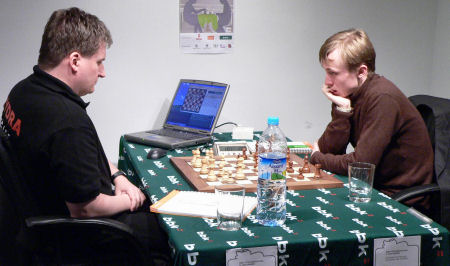
The first game to reach a climax was Hydra vs Ponomariov, in which the Ukranian genius once again forgot one of the rules relating to how the pieces move, the one we call “castling”. Instead of attempting to move his king to the Q-side in a single shot, and at the same time bringing his a8 rook into play, Ponomariov came up with the bizarre looking idea of 11…Kd7, followed by 13…Kc7 and later 18…Kb7?, a horrible looking manoeuvre.
Hydra,Syclla - Ponomariov,Ruslan [C05]
Match Mundial Personas vs Computadoras Bilbao ESP (3), 22.11.2005
1.d4 e6 2.e4 d5 3.Nd2 Nf6 4.e5 Nfd7 5.Bd3 c5 6.c3 Nc6 7.Ne2 a5 8.0-0
c4 9.Bc2 b5 10.b3N Nb6 11.bxc4 bxc4 12.Rb1 Kd7 13.Nf4 Kc7 14.Qf3 Rb8 15.Nh5!
Qe7 16.Re1 Ba6 17.Qg3 g6 18.Nf6 Kb7?
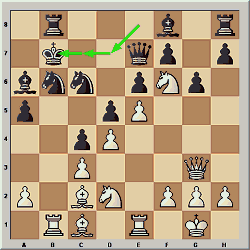
No sooner had his king reached b7 than the roof caved in – Hydra found the shot 19.Nde4! which allowed the second of his knights to wade into Ponomariov’s centre (one was already on f6) and dominate the position from the d6 square. 19...Ka7. If Ponomariov had captured the knight with 19…dxe4, Hydra would have won at once with 20.d5 Nxe5 (20...Nd8 21.d6+-) 21.Qxe5. But what Ponomariov actually played was not much better and the game lasted only another eight moves, Hydra finishing him off in fine style with a sacrifice of two pieces: 20.Nd6 Nc8 21.Ba3 Rxb1 22.Rxb1 Nxd6 23.Bc5+! Ka8 24.Ba4 Bb7 25.exd6! Qxf6 26.Bxc6 Bxc6 27.d7 Bxc5 [27...Bxd7 28.Qb8#] 28.Qc7 e5 [28...Bxd7 29.Qb7#] 29.dxc5 1-0. [Click to replay]
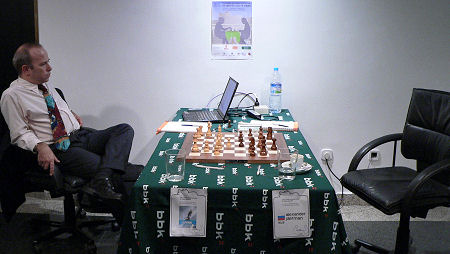
Waiting for Khalifma – Junior author Amir Ban of Israel
Junior vs Khalifman was a textbook example of how to play the white side of the Ruy Lopez. As in his round one game on the black side of this opening, Khalifman was steadily squeezed, very slowly indeed. A position was reached in which material was reduced to a queen and four minor pieces each, but with Junior having a very modest advantage in mobility. This slight advantage proved sufficient for a win, but only after Junior demonstrated a superlative technique, creating a passed pawn on the Q-side and then using this pawn to force Khalifman to give up a knight.

Former world champion Alexander Khalifman ponders...
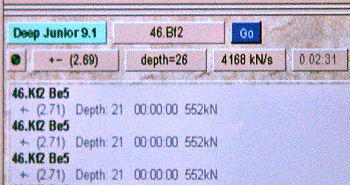
...while Deep Junior knows that it is winning.
After the game Khalifman said he was amazed that a program could play such a position so well, likening Junior’s play to Karpov at his very best. [Click to replay]
The most exciting game of the round by far was Kasimzhanov’s struggle with Fritz. For a while it appeared as though Kasimzhanov had set up a successful K-side defensive structure, with a knight on f5 and a pawn on h5. When Fritz played 10.Nd1, it may have been possible for Black to advance with …g5, and to meet Ne3 with …g4 (e.g. Nxf5 gxf3; Nxe7 fxg2). But Kasimzhanov was determined to take no unnecessary risks and, as a result of his caution, his position suddenly became critical.

Fritz - Kasimjanov,Rustam [B12]
Match Mundial Personas vs Computadoras Bilbao ESP (3), 22.11.2005
1.e4 c6 2.d4 d5 3.e5 Bf5 4.Nc3 h5!? 5.Bd3 Bxd3 6.Qxd3 e6 7.Nf3 Nh6 8.a4N
Be7 9.0-0 Nf5 10.Nd1 Nd7 11.Ne3 g6 12.a5 a6 13.c4 Nh4 14.Nxh4 Bxh4 15.b3 Be7=
16.f4 Rg8

Fritz seriously considered playing 17.cxd5 cxd5 18.f5 gxf5 19.Nxf5, which looks extremely dangerous for Black. However, to the disappointment of operator Mathias Feist it eventually chose 17.Qe2, letting Kasim off the hook for a while.
As the game developed, Kasimzhanov eventually castled Q-side and started some sort of attack along the g-file, aiming at the program’s king. Meanwhile Fritz opened up the position somewhat with c4, and created the makings of a promising looking attack against the black king. For several moves the game was balanced on a knife edge, with both players seeming to have excellent prospects at various moments. Just as the spectators were expecting an aggressive queen manoeuvre from Fritz, to a3 or c3, the program instead slid its king to h1, which might have been a waste of a vital tempo (though a cursory analysis by Fritz suggests that neither Qa3 nor Qc3 would have been superior). This king move allowed Kasimzhanov to gain some counterplay by sacrificing the exchange, and at the same time to trade queens.
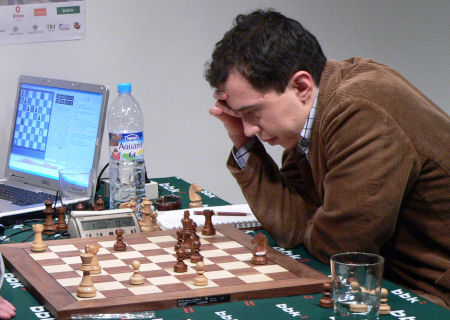
The resulting endgame was even more unclear than most of the middle game had been, with the program having a protected passed pawn on a7, another passed pawn racing up the h-file, and a third pawn (the g-pawn) creating obscure tactical chances. To add to his worries Kasimzhanov was getting a little short of time in the “guillotine” segment of the time control (the rate of play is 40 moves in 2 hours followed by all remaining moves in 1 hour). Nevertheless, he was quickly advancing his own passed pawns on the b- and c-files, and beginning to activate his knight. Fritz decided to cash in the benefits of its passed pawns, winning Black’s remaining rook in the process, creating a material situation with two rooks (Fritz) against a knight and three pawns. At this point the program had begun to access its endgame tablebases and was returning a score of zero. Kasimzhanov was down to less than seven minutes for all his remaining moves, and Mathias Feist sportingly offered a draw on Fritz’ behalf, which Kasmizhanov thought about for a couple of minutes before accepting.
17...f5 18.Ba3 Bxa3 19.Rxa3 Qe7 20.Raa1 0-0-0 21.b4 dxc4 22.Nxc4 Kb8 23.Rac1 g5 24.Nd6 gxf4 25.Rc2 Nf8 26.Qxh5 Ng6 27.Qf3 Nh4 28.Qxf4 Rg4 29.Qh6 Rdg8 30.g3 Rxd4! 31.Qe3 Rxb4 32.Kh1 Ng6 33.Qa3 Rb5! 34.Nxb5 axb5 35.Qd6+ Qxd6 36.exd6 Kc8 37.a6 Kd7! 38.a7 Ra8 39.Ra1 Kxd6= 40.Rd2+ Ke7 41.Re2 Kd6 42.h4 b4 43.h5 Nf8 44.Kg2 c5 45.Rb2 Kc6 46.h6 Kb5 47.g4 c4 48.gxf5 b3 49.fxe6 Nxe6 50.h7 Ng5 51.h8B Rxh8 52.a8Q Rxa8 53.Rxa8 Ne6 54.Rh8= ½-½ [Click to replay]
This was certainly a game of high drama, one that deserves a thorough analysis.
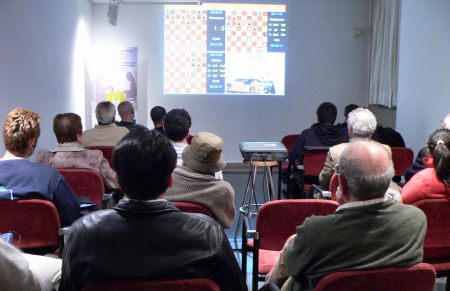
The audience at the playing venue in Bilbao
The score in the match now stands at 6.5 to the programs, 2.5 to the grandmasters, with one round remaining.